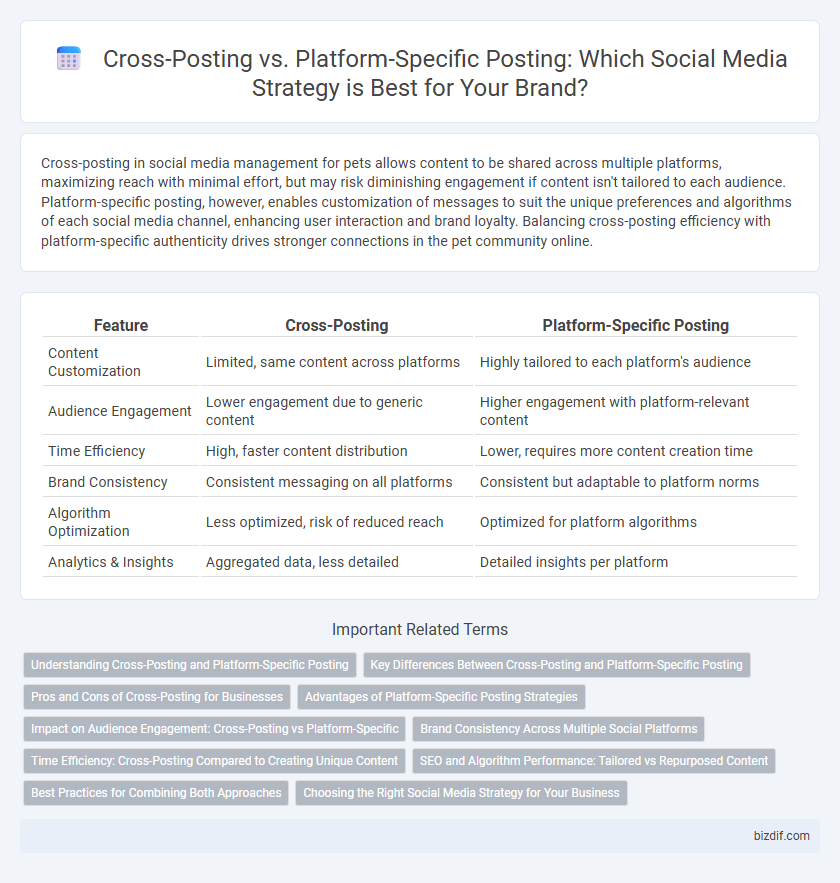Cross-posting in social media management for pets allows content to be shared across multiple platforms, maximizing reach with minimal effort, but may risk diminishing engagement if content isn't tailored to each audience. Platform-specific posting, however, enables customization of messages to suit the unique preferences and algorithms of each social media channel, enhancing user interaction and brand loyalty. Balancing cross-posting efficiency with platform-specific authenticity drives stronger connections in the pet community online.
Table of Comparison
| Feature | Cross-Posting | Platform-Specific Posting |
|---|---|---|
| Content Customization | Limited, same content across platforms | Highly tailored to each platform's audience |
| Audience Engagement | Lower engagement due to generic content | Higher engagement with platform-relevant content |
| Time Efficiency | High, faster content distribution | Lower, requires more content creation time |
| Brand Consistency | Consistent messaging on all platforms | Consistent but adaptable to platform norms |
| Algorithm Optimization | Less optimized, risk of reduced reach | Optimized for platform algorithms |
| Analytics & Insights | Aggregated data, less detailed | Detailed insights per platform |
Understanding Cross-Posting and Platform-Specific Posting
Cross-posting involves sharing the same content across multiple social media platforms to maximize reach and maintain consistent messaging, while platform-specific posting tailors content to suit the unique audience, features, and algorithms of each platform for higher engagement. Effective social media management balances cross-posting efficiency with platform-specific customization to optimize visibility and user interaction. Differentiating strategies enhances brand presence by leveraging platform strengths such as Instagram's visual-centric design or Twitter's real-time communication.
Key Differences Between Cross-Posting and Platform-Specific Posting
Cross-posting involves sharing identical content across multiple social media platforms, maximizing reach with minimal effort but risking reduced engagement due to lack of customization. Platform-specific posting tailors content to the unique features, audiences, and algorithms of each platform, enhancing relevance and interaction but requiring more time and resources. Key differences include content optimization, engagement levels, and resource allocation, making platform-specific strategies more effective for targeted marketing goals.
Pros and Cons of Cross-Posting for Businesses
Cross-posting enables businesses to save time and maintain a consistent brand voice across platforms, increasing reach and engagement potential. However, it may lead to lower platform-specific relevance, reducing user interaction due to differences in audience preferences and content algorithms. Tailoring content for each social media channel often results in higher quality engagement but demands more resources and strategic planning.
Advantages of Platform-Specific Posting Strategies
Platform-specific posting strategies leverage the unique algorithms, audience behaviors, and content formats of each social media channel, maximizing engagement and reach. Tailoring content to the platform's preferences increases relevance and interaction rates, as posts align with user expectations and trending topics. This targeted approach enhances brand visibility by optimizing message delivery for each platform's optimal posting times and styles.
Impact on Audience Engagement: Cross-Posting vs Platform-Specific
Cross-posting allows for wider content distribution but often leads to lower audience engagement due to generic messaging that fails to resonate with specific platform users. Platform-specific posting enhances audience interaction by tailoring content to the unique preferences and behaviors of each social network, resulting in higher likes, comments, and shares. Brands leveraging platform-specific strategies typically experience improved reach, better community building, and stronger customer loyalty compared to uniform cross-posting approaches.
Brand Consistency Across Multiple Social Platforms
Maintaining brand consistency across multiple social platforms is crucial for effective social media management, with platform-specific posting ensuring tailored content that aligns with each channel's unique audience and format. Cross-posting saves time but risks diluting brand voice and engagement due to varying platform norms and user expectations. Prioritizing platform-specific strategies enhances brand recognition, drives higher engagement rates, and strengthens overall social media presence.
Time Efficiency: Cross-Posting Compared to Creating Unique Content
Cross-posting significantly reduces time spent on social media management by allowing content to be published simultaneously across multiple platforms, streamlining the scheduling process and minimizing repetitive tasks. In contrast, creating unique content tailored to each platform demands more time and resources for content adaptation, formatting, and optimization to engage specific audiences effectively. Efficient use of cross-posting tools can increase overall productivity, but balancing time savings with platform-specific customization remains essential for maximizing engagement.
SEO and Algorithm Performance: Tailored vs Repurposed Content
Tailored content designed specifically for each social media platform significantly boosts SEO by aligning with unique algorithm preferences, increasing visibility and engagement. Cross-posting generic content across multiple platforms often results in lower reach due to algorithm penalties for duplicate posts. Optimizing messages based on each platform's user behavior and search patterns enhances algorithm performance and drives organic growth.
Best Practices for Combining Both Approaches
Combining cross-posting and platform-specific posting enhances social media engagement by leveraging the efficiency of shared content while tailoring messages to each platform's unique audience and format requirements. Best practices include customizing captions, hashtags, and visuals for each channel to maintain relevance and authenticity, while scheduling posts strategically to avoid content fatigue or repetition. Analyzing platform-specific performance metrics helps refine the balance between standardized and customized content, maximizing reach and interaction.
Choosing the Right Social Media Strategy for Your Business
Cross-posting maximizes content reach by sharing the same post across multiple social media platforms, saving time and ensuring consistent brand messaging. Platform-specific posting leverages unique content formats and audience behaviors on each channel, driving higher engagement and better alignment with platform algorithms. Selecting the right strategy depends on your business goals, target audience preferences, and resource availability to balance efficiency and effectiveness.
cross-posting vs platform-specific posting Infographic

 bizdif.com
bizdif.com